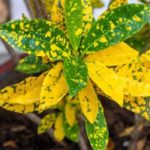In addition to apricot and peach trees, there are many other ornamental plants used during Tet to bring beauty and good fortune to the home. One such plant is the Trạng Nguyên, or “Doctor Laureate,” a shrub with vibrant red leaves and a rich history. Let’s explore the meaning of this unique plant and learn how to cultivate it.
1 What is the Red-Leaved Trạng Nguyên?
Origin of the Red-Leaved Trạng Nguyên
The Red-Leaved Trạng Nguyên, also known as Poinsettia Pulcherrima, belongs to the Euphorbiaceae family and originates from Africa, Central America, and southern Mexico. With its distinctive and vibrant colors, it has become a popular ornamental plant for Christmas and Tet celebrations in various countries.
 The Red-Leaved Trạng Nguyên, a member of the Euphorbiaceae family
The Red-Leaved Trạng Nguyên, a member of the Euphorbiaceae family
This shrub was first discovered in 1834, and its striking colors quickly made it a favorite for decorative purposes during special occasions. As a result, it has earned additional names such as the Christmas Flower, First-Class Red, and Leaf-Top Flower.
 The versatile Trạng Nguyên shrub goes by many names
The versatile Trạng Nguyên shrub goes by many names
Characteristics of the Red-Leaved Trạng Nguyên
The Trạng Nguyên is a bushy shrub with a woody stem that can grow up to 4 meters tall. Its leaves are shaped like lances, with a deep green color and a pointed tip. The flowers of the Trạng Nguyên are a vibrant red, arranged in a circular pattern. However, these flowers are actually quite small and yellow, surrounded by the shrub’s distinctive red leaves, with deeper green or yellow leaves below.
 The Trạng Nguyên is a bushy shrub with a woody stem
The Trạng Nguyên is a bushy shrub with a woody stem
With its rapid growth, vivid colors, and lush appearance, the Trạng Nguyên is a popular choice for ornamental gardens. However, it is important to note that this plant contains toxins that can cause nausea, diarrhea, and headaches for those allergic to its sap, fragrance, or other components. Therefore, it is recommended to keep children and individuals with a history of pollen allergies away from the plant.
2 The Benefits of the Trạng Nguyên Shrub
 The Trạng Nguyên shrub offers a range of benefits
The Trạng Nguyên shrub offers a range of benefits
The Trạng Nguyên is not just a beautiful plant but also has practical applications. It can be used as an ornamental shrub to add a splash of color to homes during festive occasions like Tet and Christmas. Moreover, it helps purify the air by absorbing smoke and dust, creating a healthier and more vibrant living space.
Beyond its decorative and air-purifying qualities, the Trạng Nguyên also has medicinal uses in traditional Eastern medicine. According to this practice, the plant has a bitter and astringent taste, a cool nature, and mild toxicity. It is believed to regulate the flow of energy in the body, stanch bleeding, heal bone fractures, and treat external injuries and chronic intestinal pain. Additionally, it is used to treat snake and insect bites and relieve pain.
3 The Feng Shui Significance of the Trạng Nguyên
Apart from its aesthetic and medicinal values, the Trạng Nguyên is also chosen for its positive feng shui implications. Its vibrant colors are thought to attract wealth and good fortune to the homeowner.
 The Trạng Nguyên is believed to bring academic success
The Trạng Nguyên is believed to bring academic success
Furthermore, the Trạng Nguyên is considered a symbol of academic success and achievement. Its name originates from a folk tale about a student who, on his way to take an imperial exam, picked a strange flower by the roadside. When he passed the exam with flying colors, the flower’s petals turned red in celebration of his achievement.
In ancient times, the color red was associated with the Trạng Nguyên, the top position in the “Tam Nguyên” hierarchy during the feudal era. Thus, the plant came to symbolize good luck and success in exams and endeavors. It is often given as a gift to students, wishing them smooth sailing and triumph in their academic pursuits.
 The best places for the Trạng Nguyên are near the main entrance or study desk
The best places for the Trạng Nguyên are near the main entrance or study desk
The ideal feng shui locations for the Trạng Nguyên are near the main entrance or study desk. Placing a pot of this shrub near your work area can enhance your focus and productivity. Alternatively, planting it near the main entrance is believed to attract positive energy, promoting good health and smooth endeavors for the family.
4 Compatibility with Zodiac Signs and Elements
The Trạng Nguyên’s combination of red and deep green leaves represents the Fire, Earth, and Wood elements. According to the Five Elements theory, Wood fuels Fire, and Fire produces Earth. Therefore, this plant is especially auspicious for individuals with Fire and Earth elements and zodiac signs. The following is a list of years associated with these elements.
 The Trạng Nguyên is ideal for those with Fire and Earth zodiac signs
The Trạng Nguyên is ideal for those with Fire and Earth zodiac signs
Fire element zodiac signs: Mậu Tý (1948, 2008), Kỷ Sửu (1949, 2009), Bính Dần (1986), Đinh Mão (1987), Giáp Thìn (1964), Ất Tỵ (1965), Mậu Ngọ (1978), Kỷ Mùi (1979), Bính Thân (1956, 2016), Đinh Dậu (1957, 2017), Giáp Tuất (1934, 1994), Ất Hợi (1935, 1995)…
Earth element zodiac signs: Canh Tý (1960), Tân Sửu (1961), Mậu Dần (1938, 1998), Kỷ Mão (1939, 1999), Bính Thìn (1976), Đinh Tỵ (1977), Canh Ngọ (1930, 1990), Tân Mùi (1931, 1991), Mậu Thân (1968), Kỷ Dậu (1969)…
For individuals with Fire and Earth elements, the Trạng Nguyên is believed to attract wealth and good fortune, promote harmony in the family, and bring success in exams and endeavors. Due to the presence of light-colored leaves, the plant also suits those with the Metal element, but to a lesser extent, as Fire overcomes Metal, and although Earth produces Metal, it is not enough to counterbalance the Fire element.
5 Is the Red-Leaved Trạng Nguyên Toxic?
 The Red-Leaved Trạng Nguyên has low toxicity
The Red-Leaved Trạng Nguyên has low toxicity
The Red-Leaved Trạng Nguyên has low toxicity. However, ingesting its leaves may cause mild gastrointestinal distress due to inflammation of the stomach and intestines. Therefore, it is essential to exercise caution if you have young children or pets at home.
6 How to Grow and Care for the Trạng Nguyên
Growing the Trạng Nguyên
There are several ways to grow the Trạng Nguyên, including purchasing young plants, propagating from seeds, or cutting and replanting branches. However, the latter methods can be time-consuming, and it is generally faster and less risky to purchase young plants from nurseries.
Growing Trạng Nguyên from Young Plants
When selecting young plants, opt for those that look healthy and vibrant, free from pests and diseases. Decide whether you want to plant them in pots or directly in the ground.
For pot planting
 The best spot for ground planting is near the main entrance
The best spot for ground planting is near the main entrance
The ideal location for ground planting is near the main entrance of your home. Dig a hole, place the young plant inside, cover its roots with soil, and water it gently.
Propagating Trạng Nguyên through Branch Cutting
 Branch cutting is another effective method for growing Trạng Nguyên
Branch cutting is another effective method for growing Trạng Nguyên
-
Choose a healthy branch from the mother plant, approximately 10cm long, free from pests and diseases.
-
Remove the leaves and soak the cut end in a rooting hormone solution.
-
Plant about ⅓ of the branch into a prepared pot or garden bed, and water it gently.
Caring for the Trạng Nguyên
After planting your Trạng Nguyên, it’s crucial to understand how to care for it properly to ensure its health and promote flowering.
Watering
Maintain moist soil for your Trạng Nguyên, especially during the initial stages after planting. Water the plant gently at the base, allowing the water to slowly soak into the soil. This plant does not require overly moist conditions, and moderate moisture is sufficient.
 Water your Trạng Nguyên once or twice a day under normal weather conditions
Water your Trạng Nguyên once or twice a day under normal weather conditions
Water your plant once or twice a day, depending on the weather. When watering the Trạng Nguyên in your garden, avoid using too much force, especially during the fall when there are more insects in the soil. Strong watering can cause soil organisms to splash onto the plant, leading to pest problems.
Fertilizer
 The Trạng Nguyên is sensitive to fertilizer, so use it sparingly
The Trạng Nguyên is sensitive to fertilizer, so use it sparingly
The Trạng Nguyên is sensitive to fertilizer, so avoid applying large amounts directly to the roots, as this can cause fertilizer burn and root damage. Instead, use a diluted NPK (20:20:20) solution or slow-release fertilizer once a month.
Light and Temperature
The Trạng Nguyên thrives in temperatures between
2023 Lunar New Year Gift Ideas for Older Family and Friends
As 2021 approaches, families worldwide are gathering to celebrate the special bond between grandparents and their grandchildren. To show their love and admiration, these thoughtfully chosen gifts will bring a smile to the face of the elderly. Here, we have compiled a list of the 13 most meaningful Tet presents that can bring joy to our beloved grandparents.



































